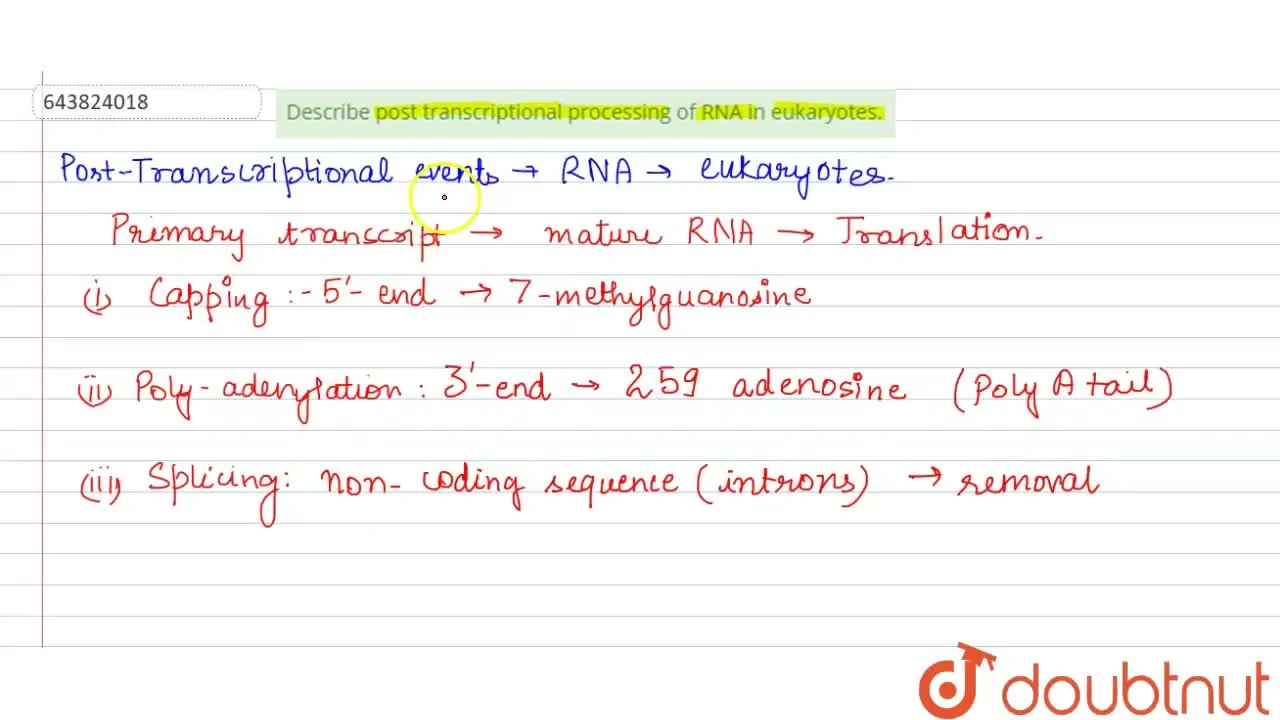Describe post transcriptional processing of RNA in eukaryotes.
Messenger RNA production requires synthesis of a pre-mRNA by RNA Pol II and processing of the nascent precursor by 5. capping, splicing of introns, and 3. cleavage or polyadenylation to make mature mRNA.
(i) Splicing : In molecular biology, splicing refers to editing of the precursor messenger RNA (pre-mRNA) transcript into a mature messenger RNA (mRNA) wherein introns are removed and exons are joined together i.e., they are ligated. Splicing occurs within the nucleus after transcription.
(ii), Capping : While the pre-mRNA is synthesized, a 7-methylguanosine cap is added to the 5. end of the growing transcript by a 5-to-5. phosphate linkage. In molecular biology, the fiveprime cap (5. cap) is a specially altered nucleotide on the 5. end of some primary transcripts, this process is known as mRNA capping. This is a highly regulated and vital process for forming stable and mature messenger RNA able to undergo translation during protein synthesis. The cap protects the nascent mRNA from degradation. Moreover, initiation factors involved in protein synthesis recognize the cap to help initiate translation by ribosomes.

(iii) Tailing : An enzyme called poly (A) polymerase (PAP) is a part of the protein complex that cleaves the pre-mRNA and it immediately adds a string of approximately 200 A nucleotides, called the poly (A) tail, to the 3. end of the just-cleaved pre-mRNA. The poly (A) tail protects the mRNA from degradation, aids in the export of the mature mRNA to the cytoplasm, and is involved in binding proteins involved in initiating translation.
Related Playlists
Similar Questions
Which of the following is not required during post transcritional processing in eukaryotes?
View SolutionWhich of the following events take place during post - transcriptional modification in eukaryotes ?
View SolutionAssertion : Eukaryotic mRNA requires post transcription processing for formation of functional mRNA.
Reason : Eukaryotic transcripts possess extra non-functional segments called introns.View SolutionGive an account of post transcriptional modifications of a eukaryotic mRNA.
View SolutionExplain the post transcriptional modifications the hn-RNA undergoes in eukaryotic cell.
View Solution(a) Give reason for -
(i) Both strands of DNA are not copied during transcription.
(ii) Transcription and translation in bacteria can be coupled.
(b) Differentiate between the process of transcription in prokaryotes and eukaryotesView SolutionA : Single DNA depenedent RNA polymerase catalyases transcription of all types of RNA in all except bacteria.
R: Structural genes in bacteria are monocistronic .View SolutionDescribe the process of transcription in a bacterium.
View SolutionWhat are the transcriptional products of RNA polymerase III?
View SolutionExplain the process of RNA interference.
View Solution


